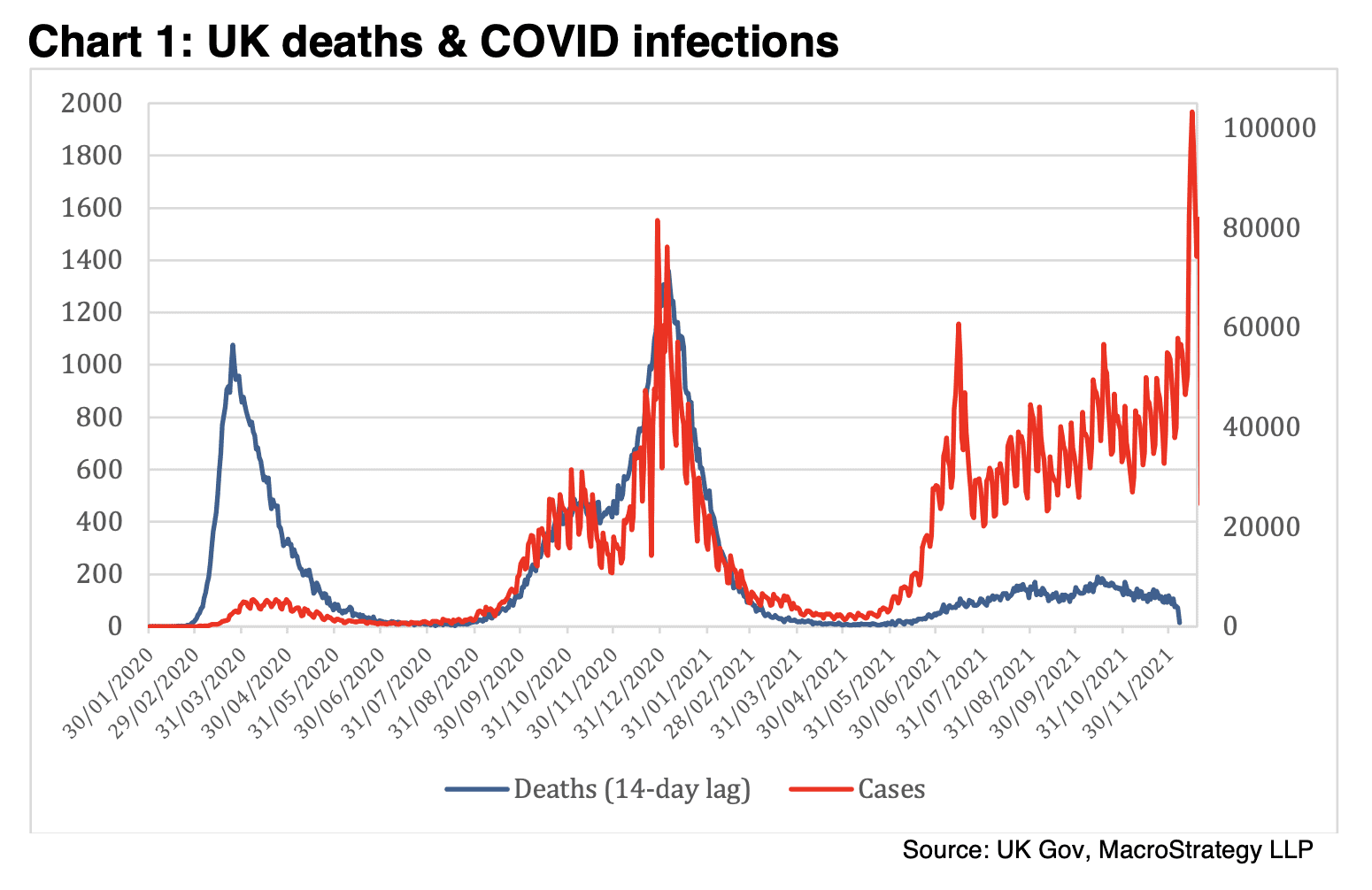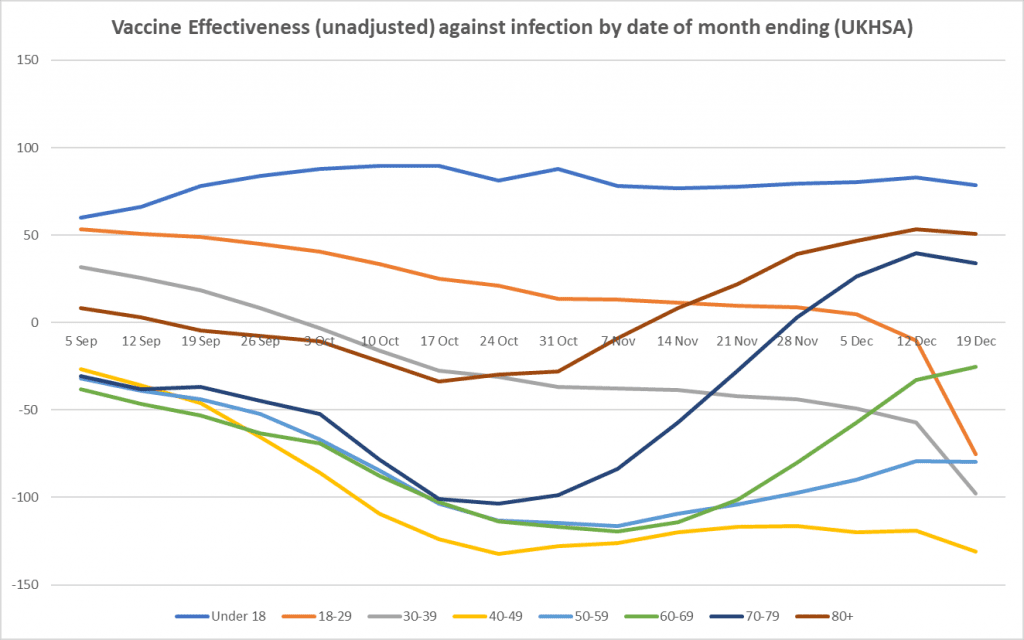

You Are a Third Less Likely to Catch Covid this Christmas Than Last Christmas and 80% Less Likely to Die From It. So Why the Panic?
We’re republishing the latest analysis by James Ferguson, a financial analyst, which argues – quite convincingly – that not only is Omicron considerably milder than Delta but also less transmissible.
Almost a year ago to the day, I noted that the reasons given for closing down Christmas celebrations in the U.K. last year had owed more to a basic mathematical error than the supposed increased transmissibility and virulence of the new alpha (Medway) variant.
This year, a similar threat from omicron appears to be scaring the politicos, but this again seems more a figment of the scare-mongers’ hysteria than scientifically-grounded evidence.
The willful damage that certain so-called scientists have serially inflicted on the economy needs to be queried. However, the propaganda machine likens any healthy skepticism to flat-earth advocacy.
Consequently, this note takes a leaf out of Steven Koonin’s excellent book on the climate debate Unsettled, and only interprets the Government’s own official data.
However, as you will see below, this interpretation comes out quite differently to the Government propaganda/BBC party line. Covid, as is the way with new viruses, is mutating into both a significantly less transmissible and substantially less virulent variant.
You are only about one third as likely to catch Covid this Christmas as last and, even if you do, you are now 80% less likely to die from it. So, why isn’t this the new narrative?
Same Government data, different headlines.
A fifth wave?
The UK is currently in the throes of its fifth Covid variant wave: Wuhan (Mar 2020), Spanish (Sep 2020), alpha (Nov 2020), delta (Jun 2021) and now omicron (Dec 2021). Cases are at a record high, despite one of the most comprehensive vaccine programmes in the world and a series of extensive non-pharmaceutical interventions (NPIs), like lockdowns and forced self-isolation. Yet behind the media hysteria, an extremely salient fact seems to have gone largely unnoticed. Whilst the number of positive tests has hit new highs (see red line on Chart 1 below), the number of deaths which used to follow just 14 days behind such ‘cases’ have fallen away, especially since omicron (blue line).


Prescription discrepancy
If this far lower death rate has been a triumph for the vaccines, they don’t seem to have done anything to prevent actual infection. If, on the other hand, the lower Covid death rate is due to better hospital treatment, including the drugs which have now (finally) been approved (the antibody drug sotrovimab and the antiviral molnupiravir), then why are emergency approval-only vaccines, which have yet to be safety- checked, still being prescribed? It’s a mystery.
Record Cases
The main problem seems to be that the political narrative of the pandemic has strayed quite a distance from what even the Government’s own data is saying. Officially there are only five numbers released by H.M. Government to the press and public: tests, cases, hospitalisations, vaccinations and deaths. However, even this paltry list is barely ever analysed. For example, on Wednesday December 22nd, the BBC reported that a record 106,122 cases were reported and that “the eight highest daily case figures… have all come since December 15th.” Yet as the blue line on Chart 2 below shows, the official Government data reveal that this is lazy reportage. The number of cases by specimen date (as opposed to the date the test results were reported), had already peaked on December 15th at 103k and has declined by about 20% since then.


Positivity
Far more relevantly, so-called ‘cases’, which remain undiagnosed by doctors and are merely positive PCR test results, are quite naturally a function of several other several factors, not just the Covid infection rate. First and foremost amongst which is the number of tests taken. It is not the number of positive cases that indicates how widespread infection is, but the proportion of those tested that are positive. This ‘positivity rate’ (positive cases as a percentage of tests administered) is of far more relevance to how widespread COVID is than the absolute number of positives; and positivity has been stable, at around 4-5%, since as far back as early July 2021 (see red line). Thus, the apparent spike in cases, that the BBC news headlines scream out, is a mere figment of the corporation’s fevered imagination.
When is a ‘positive’ not a positive?
Another important, and highly relevant, issue is the sensitivity of the polymerase chain reaction (PCR) test itself, or more importantly, the cycle threshold chosen for determining a ‘positive’ result. Conclusive positive confirmation of a positive PCR test, by successfully sequencing the virus in the lab, is uncertain above 20 cycles (1 million copies) and impossible above 30 cycles (1 billion). Since each PCR cycle doubles the number of viral copies, 30 cycles = 2 to the power of 30. The UK is still counting PCR tests as ‘positive’ for cycle thresholds “> 37”, which multiplies each of the existing viral strands by at least 270bn.
Naturally, quite a bit of viral shredding, the biological equivalent of Chinese whispers, occurs with so many doublings and the reliability of the result degrades proportionally. Even the inventor of the PCR process advised that his method never be used for diagnostics. Nevertheless, from the Government data alone, we can now tentatively conclude several things.
First, there appears to be no discernible omicron wave. The apparent ‘record’ high cases are entirely explained by the increased number of daily tests being administered (a record high 1.64m on December 15th).
Second, the vaccine, largely rolled out by end-June, doesn’t seem to have had much prophylactic efficacy since July (hence the messaging moving onto the prevention of serious illness, hospitalisation and death).
Third, the omicron variant appears no more transmissible (i.e., it has much the same positivity rate) than its predecessor, the delta variant.
Fourth, Covid, in both its delta and now omicron variants, appears to have become endemic. There have been no clearly distinct ‘waves’ in the positivity data since last summer, just a fairly continual 4-5% detectable infection rate.
Fifth, whilst the bad news is that these new variants may not be burning themselves out as fast as their predecessors, the good news is that the positivity rate is two thirds to three quarters lower now. Both delta and omicron appear less, as opposed to “more”, transmissible (despite alarmist insinuations to the contrary).
Unintended consequences
Normally, viruses select for more transmissible but less virulent variants. People walking around infected but relatively asymptomatic naturally infect far more people and spread the virus further than those bedridden with a more virulent strain. Therefore, NPIs may have prevented these more transmissible but less virulent Covid variants from becoming dominant. This begs the question: if Covid is now less (or at least no more) transmissible, is it perhaps therefore more virulent? Fortunately, the answer at this stage appears to be ‘no.’
Hospitalisation rate
Little can be said about Wave 1 (Wuhan), because hardly anyone outside of hospital was tested, but the late summer 2020 Wave 2 (the Spanish variant), seems to have had a lower hospitalisation rate than the later alpha (Medway) variant that peaked in New Year 2021 (see red and blue lines in Chart 3 below).


Getting lucky
By inhibiting transmission of the milder variant therefore, NPIs might have been contributing to some increased COVID virulence. Yet nevertheless, since last summer’s delta variant, we appear to have got lucky. With total hospitalisations lagging increased positivity, compared to last winter’s alpha variant, delta and omicron seem, if anything, to have resulted in a smaller number of infections requiring hospitalization than delta and, in the case of omicron, only about half as many as alpha did.
Meanwhile, Brits’ chances of dying, if seriously infected enough to require hospitalisation, have improved substantially. During the winter of 2020, deaths rose to about a third of all COVID hospitalisations. Whilst this was only half the number of hospitalised succumbing during the first wave, it still wasn’t a great advertisement for the overall quality of care. However, survival chances for those on the wards have doubled again since then, to about 15% (see Chart 4 below), and as Chart 3 above already showed, the chances of being hospitalised have also halved since a year ago.


Conclusion
Around about this time last year, over 15% of all those tested for Covid in the U.K. pinged positive, as the more transmissible and virulent alpha variant swept the land. Fast forward to this Christmas, and the tail-end of delta, along with the emergent new omicron variant, are generating a 5% positive rate (see blue line on Chart 5 below), suggesting that these newer variants are perhaps only one third as transmissible as alpha was. Whereas a 15% positive rate of infection was resulting in around 1300 deaths a day at the peak of the alpha variant, a positive rate of only about one third of that is this winter only resulting in about 75 daily deaths (less than 20% of the expected rate). Furthermore, this death rate is declining and has halved again over the last two (omicron) months. All of which means you are now 80% less likely to die of Covid this Christmas than last (red line). How’s that for Christmas cheer?










